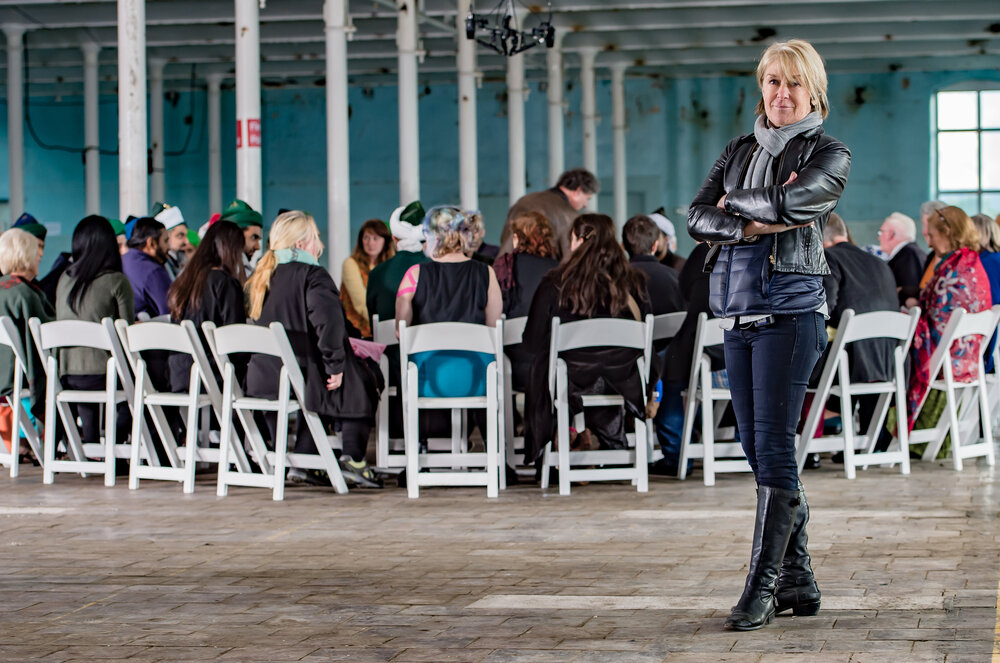
Courtesy SuzanneLacy.com
Suzanne Lacy is a renowned social practice artist who incites social change by directly engaging with the public. Lacy is known for addressing social issues such as feminism, racism, ageism, and equal rights. Lacy does this through visual art, video, performance art, installation, and writing.
Suzanne Lacy was born in Wasco, California in 1945.[1] Lacy went to Bakersfield
Community College in 1963 and received a scholarship to the University of California at Santa Barbara (UCSB) in 1965. At the University of California at Santa Barbara Lacy majored in zoology, minored in chemistry, and took classes in dance and art. In Lacy´s postgraduate years she studied psychology and took classes with the feminist artist Judy Chicago at Fresno State College.[2] The feminist art movement in the late 1960s to the 1970s challenged male dominance by seeking equality for women and questioning traditional woman´s roles. Lacy was influenced by this art movement and other social injustices occurring at Fresno State College. Faculty and students were protesting conservative administration, corporization, and lack of support for minorities. Lacy left Fresno State College and joined the California Institute of the Art´s Feminist Art Movement in 1971.[3] The Feminist Art Program influenced most of the faculty who was recently hired by Herb Blau and the School of Art Dean, Paul Brach, assisted by Fluxus artist, Allan Kaprow. Fluxus was an art movement that sought to unite art and everyday life through chance and humor. Kaprow brought visual art, sound, and movement to his Happenings or performance pieces, and he considered how body movements produced a type of language. Influenced by Kaprow, Lacy considered the emotional and instinctive aspects of everyday life, and her early artworks focused on bodily mortality. Most of Lacy´s art has been impacted by her training in feminism and interest in social interaction within artistic practice. Lacy has performed in the United States, London, British Columbia, Scotland, Taiwan, Germany, and countries throughout the world.[4] Lacy is also a professor for the University of South California´s Roski School of Art and Design.[5]
Suzzane Lacy Artwork
Some of Lacy’s famous artworks include Three Weeks in May (1977), The Crystal Quilt (1985-1987), and Prostitution Notes (1974).
Three Weeks in May (1977)
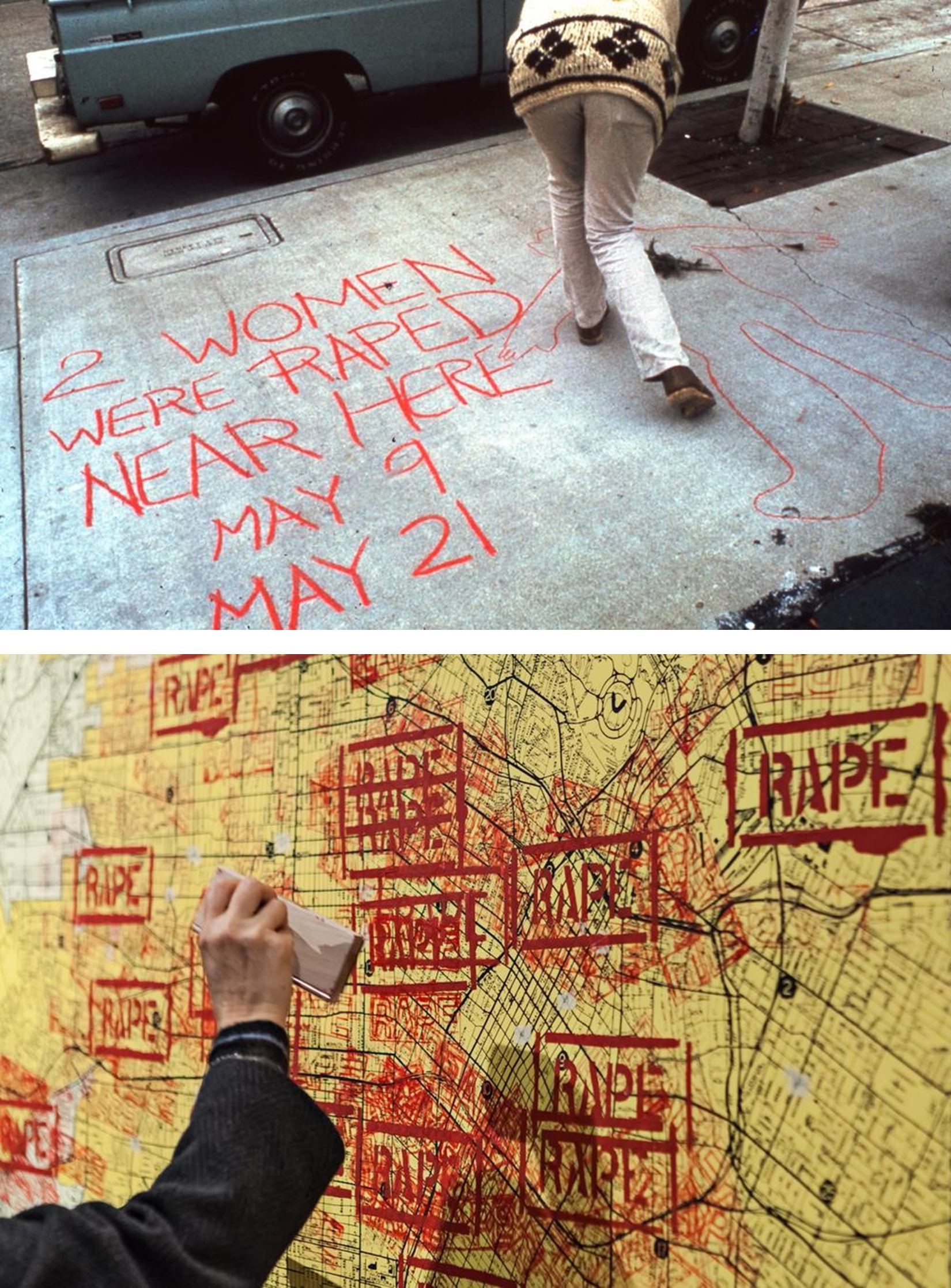
For Three Weeks in May (1977) Lacy and collaborators chalked sidewalks of places where rapes occurred.[6] For example, the first image above states, ¨2 WOMEN WERE RAPED NEAR HERE MAY 9 MAY 21¨.[7] Below this image is a map of Los Angeles that Lacy stamped with the word RAPE in red ink to indicate locations where rape occurred over the course of three weeks. Ninety rapes occurred within this time span. Juxtaposing this map was another that located treatment centers, shelters, and organizations in Los Angeles. These maps were installed in the City Mall, a shopping arcade in the City Hall of downtown Los Angeles.
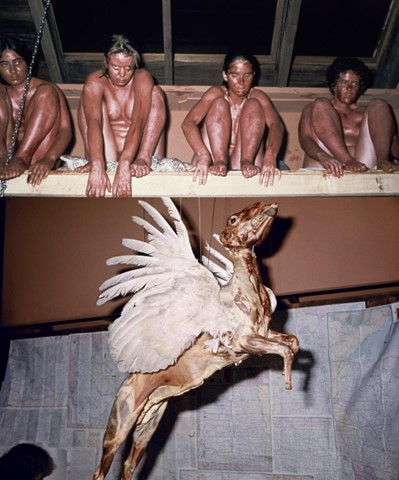
The third image consists of four women who were raped, presented as naked, covered in red paint, staring down at the viewer. A flayed lamb carcass with feathered wings is suspended from the ceiling. In the background, pinned to a map, are stories of those who have been raped. This small-scale installation is supposed to show how the ¨consciousness wrests free from the body during a rape¨.[8] For Three Weeks in May Lacy also set up public art performances in the street, radio programs, workshops, public statements, and self-defense classes.
The Crystal Quilt (1985-1987)
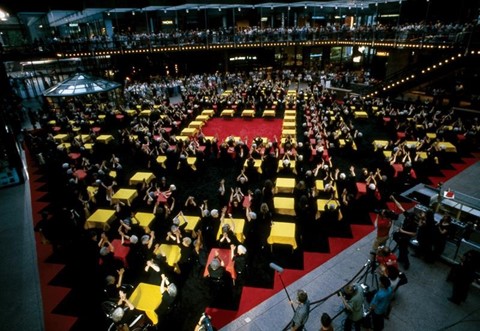
The image above is The Crystal Quilt (1985-1987) which features 300 Minnesota women over the age of 60 seated at tables.[9] Below the tables is an 82-foot rug or quilt. A pre-recording of statements from seventy-two women on the uncultivated potential of the elderly is announced on a loudspeaker. A loon cry or thunderclap occurs every few minutes to indicate for the women to change the position of their hands and therefore, change the pattern of the quilt. Lacy created events, classes, lecture series, film screenings, and a mass media campaign over the course of two years for The Crystal Quilt.
Prostitution Notes (1974)
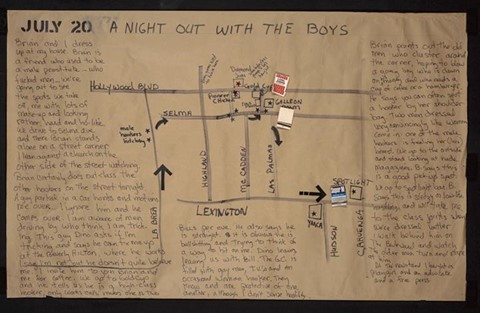
The image above is a map made for Lacy´s performance Prostitution Notes (1974).[10] Lacy went around Los Angeles with friends and acquaintances to understand the dynamics of prostitution. The map consists of Lacy´s personal observations of the social places she visited, the conversations she had, and the routes she took within Los Angeles. A performative video reading by Suzanne Lacy and coproduced by Peter Kirby was also made to describe these experiences.
Bibliography
- Irish, Sharon. Suzanne Lacy: Spaces Between. (University of Minnesota Press, 2010). 23.
- Jones, Amelia. ¨Suzanne Lacy Between Kaprow and Chicago: Pedagogy and Performance. ¨ TDR: The Drama Review, 65. No. 4. (Cambridge, 2021).
- Lacy, Suzanne. Prostitution Notes. (1974).
- Lacy, Suzanne. The Crystal Quilt (1985-1987).
- Lacy, Suzanne. Three Weeks in May (1977).
- [1] Sharon Irish. Suzanne Lacy: Spaces Between. (University of Minnesota Press, 2010). 23.
- [2] Amelia Jones. ¨Suzanne Lacy Between Kaprow and Chicago: Pedagogy and Performance. ¨ TDR: The
- Drama Review, 65. No. 4. (Cambridge, 2021).
- [3] Sharon Irish. Suzanne Lacy: Spaces Between. 27-30.
- [4] Ibid. 175-183.
- [5] Amelia Jones. ¨Suzanne Lacy Between Kaprow and Chicago: Pedagogy and Performance. ¨
- [6] Sharon Irish. Suzanne Lacy: Spaces Between. 63-67.
- [7] Suzanne Lacy. Three Weeks in May (1977).
- [8] Ibid. 67.
- [9] Suzanne Lucy. The Crystal Quilt (1985-1987).
- [10] Suzanne Lucy. Prostitution Notes. (1974).
